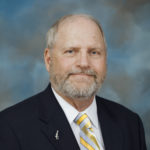 Jack Payne has led the University of Florida’s Institute of Food and Agricultural Sciences as Senior Vice President since 2010. Now at his fifth land-grant university, he is passionate about the research, teaching and Extension missions and insists that land-grant institutions will have to play a central role in meeting many of the grand challenges of our times. He likes to say the state is his office. Indeed it is, as he oversees Extension offices in all 67 Florida counties and 12 research and education centers. He travels the state frequently to visit with growers, land managers, association leaders, legislators and employees. Biography paraphrased from UF/IFAS.
Jack Payne has led the University of Florida’s Institute of Food and Agricultural Sciences as Senior Vice President since 2010. Now at his fifth land-grant university, he is passionate about the research, teaching and Extension missions and insists that land-grant institutions will have to play a central role in meeting many of the grand challenges of our times. He likes to say the state is his office. Indeed it is, as he oversees Extension offices in all 67 Florida counties and 12 research and education centers. He travels the state frequently to visit with growers, land managers, association leaders, legislators and employees. Biography paraphrased from UF/IFAS.
By Dr. Jack Payne
UF/IFAS Senior Vice President for Agriculture and Natural Resources
There isn’t a shortcut to trust. Like the proverb says, it takes years to build, seconds to break, and forever to repair.
So Dr. Natalia Peres got busy working on putting in the years as soon as she got to the UF/IFAS Gulf Coast Research and Education Center in Wimauma more than a decade ago.
Al Herndon managed a strawberry farm in Floral City at the time, and he’s still a consultant. Before a weather station was installed, Herndon’s information source was a daily call to Peres on his mobile phone.
By Herndon’s account, it took some time for Peres to really figure out what the growers’ problems were. After enough phone calls with weather information and listening to what Herndon was seeing in his fields, though, she earned his trust.
That made her a credible messenger for science. That’s what every UF/IFAS faculty member should aspire to.
It takes years to build trust, and then a few weeks to measure it. The PIE Center put in those weeks this past fall with a survey. It’s important work because when our scientists build trust with the public, they increase trust in science itself.
We start with more than two-thirds of the public already on board. The survey found that 68 percent of respondents agreed or strongly agreed with the statement, “Scientists contribute to the well-being of society.”
Slightly more than 63 percent of respondents agree that “Scientific research should be supported by the federal government.”
The glass is about two-thirds full, but we have much work to do outside the lab to ensure that our work has the impact we all hope for.
For Peres, trust was absolutely essential for her to get her science out of the lab.
She wanted to develop a model for determining when to spray for certain diseases. To Herndon, what Peres meant was that he was, quote, “not supposed to spray unless her little computer told me to.”
Herndon told her it wouldn’t work. Trying something new is risky, so he needed to trust Peres. Because she’d earned that trust, he agreed to nine rows where he’d follow reduced fungicide spraying instructions from Peres’s strawberry advisory system.
It worked. Herndon remained skeptical. Could be those nine rows benefited from the more heavily treated rows around them. So he went to five acres. And he saw the same results.
Peres has published in academic journals about the success. We’ve done news releases touting the huge financial savings for growers. Herndon summed it up by simply saying, “The hell of it is, it works!”
Every year he and Peres argue about the advisory system. But then she takes that input, goes back to the lab, and makes her system even better. Knowing she’ll listen and respond gives her – and science’s search for constant improvements – that much more credibility.
Peres exemplifies the impact we can all make by combining excellence in the lab with trust-building out in the field.
Trust is a feeling, a belief. We can give people reason to believe by calling them on mobile phones, walking their rows, and demonstrating before their eyes that our solutions serve them.
It’s as labor-intensive as agriculture itself. But that’s why trust takes years to build.
















